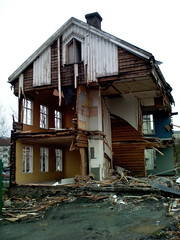 |
| Photo By Andreas Solberg via Flickr |
This might be old news for some, but I still find the story very inspirational and thus worth spreading.
Teenagers often have silly ideas. I can assure you I had quite a few when I was fourteen. For some reason it never crossed my mind to ask my parents to sell our house, move in to a house worth half the price of the old one and donate extra money to charity. But when Hannah Salwen was fourteen years old that is exactly what she came up with. And to everyone's surprise her parents sold the house and donated eight hundred thousand dollars to villagers in Ghana through the hunger project.
After selling the house Hannah and her father Kevin wrote a book called "The Power of Half" of their experience. They've appeared on television and in several newspapers and magazines. They also travel around to talk about their project at schools, community centers and so on.
I have not yet had a change to read the book, but I still find the story as an amazing manifestation of how silly idealism can lead to real life-changing results both at individual and global level.
The Salwens changed their own life for better by realizing that aspiring for new possessions does not make the family any happier. They also realized that they spent more time together as a family when living in a smaller house. The whole process forced them to work together and talk a lot.
The project also changed the lives of people from 40 villages in Ghana. Most importantly though the book and the project have created a lot publicity and momentum for the idea of everyone having a half they can give a way. It might be half of the house, but it could just as well be half of the items in the wardrobe or half the money one would spent on beer on a Friday night.
By surrendering to silly teenage idealism the Salwens transformed their own lives and thousands of other lives for better. How amazing is that?
Teenagers often have silly ideas. I can assure you I had quite a few when I was fourteen. For some reason it never crossed my mind to ask my parents to sell our house, move in to a house worth half the price of the old one and donate extra money to charity. But when Hannah Salwen was fourteen years old that is exactly what she came up with. And to everyone's surprise her parents sold the house and donated eight hundred thousand dollars to villagers in Ghana through the hunger project.
After selling the house Hannah and her father Kevin wrote a book called "The Power of Half" of their experience. They've appeared on television and in several newspapers and magazines. They also travel around to talk about their project at schools, community centers and so on.
I have not yet had a change to read the book, but I still find the story as an amazing manifestation of how silly idealism can lead to real life-changing results both at individual and global level.
The Salwens changed their own life for better by realizing that aspiring for new possessions does not make the family any happier. They also realized that they spent more time together as a family when living in a smaller house. The whole process forced them to work together and talk a lot.
The project also changed the lives of people from 40 villages in Ghana. Most importantly though the book and the project have created a lot publicity and momentum for the idea of everyone having a half they can give a way. It might be half of the house, but it could just as well be half of the items in the wardrobe or half the money one would spent on beer on a Friday night.
By surrendering to silly teenage idealism the Salwens transformed their own lives and thousands of other lives for better. How amazing is that?